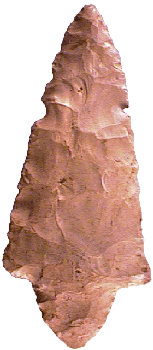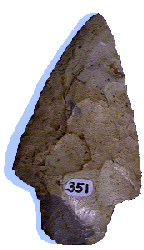



Point Type: GARY
Also See: Adena,
Adena
Narrow Stemmed, Buggs
Island, Ebenezer, Hidden Valley, Hillsborough,
Langtry, Morrow Mountain, Newnan, Randolph, Harrison Turkey
Tail, Wells
Location: Eastern Texas, Louisiana, Alabama, Missouri, Arkansas, Tennessee, Kentucky, So. Illinois and So. Indiana
Associated Dates:
4000 - 1000 B.P. - Late Archaic to Woodland
Morphology: Stemmed
General Description: The Gary point is a medium sized, triangular bladed point / knife type with indistinct , squared shoulders, and a medium to long, contracting, pointed to rounded stem base. The blade edges are straight to excurvate but sometimes concave or recurvate. The shoulders may be small but usually flare out widely almost at right angles. Barbs, if present at all, are short. Stems usually contract strongly to a pointed or somewhat rounded base but may at times approach being parallel sided. The Gary is a relatively crude and thick point with a large range of outline shape variation. It is apparent that two different preforms were employed in making of the Gary point. One preform was triangular and the other was ovate. The result is two different primary outlines for the Gary type.
The Gary seems to have lasted for a long time period of use. Some authors feel that the Gary point type undergoes a gradual diminution in size through time (Ford & Webb 1956:52-54). The Gary has been categorized as part of the Contracting Stem point family with other similar blades such as the Morrow Mountain I and II, Wells, and the Adena point. The Gary point is typically found in the Mississippi River basin states, especially Texas, Arkansas, Missouri and Louisiana.
The size of the Gary point ranges from 25 mm to 85 mm in length. The width ranges from 20 mm to 45 mm. The thickness ranges from 9 mm to 10 mm. The stem length is more consistent than the length of the blade; on shorter specimens the stem is almost 1/2 of the total length while on longer specimens, the stem length is about 1/4 to 1/3 of the total length. The "Gary Contracting Stem" point was named in 1949 by Perry H. Newell and Alex D. Krieger for their work at the George C. Davis site in Cherokee County, Texas. It had been previously referred to as the "Dead-Man Triangle Point" by F. Bryan in 1936 and the "Denton Nub-Stemmed" by W. W. Crook, Jr. and R. K. Harris in 1954. Gary points were usually knapped from pebble cherts in Louisiana, Novaculite in Arkansas and Edwards cherts in Texas.
About the Point Above (Left): The point pictured above on the left hand side of the page is a very large Gary point made of khaki tan chert. The point measures 83.5 mm in length, 34 mm at the widest point and is 8 mm thick at the base of the shoulders with most of the blade being 6 mm thick. The stem is 18 mm long and 17 mm wide at mid point and has been thinned to 5 mm in thickness. The blade has two nicks, one on each blade edge 27 mm from the tip. This point was once in the Bob Miller collection and was found in Cass County, Texas. Catalog Number 92-31-N
About the Point Above (Right): The point pictured above on the right hand side of the page is a small Gary point made of a dark cream colored waxy flint with a darker gray colored flint in the corner of the stem. The point measures 64 mm in length, 34 mm at the widest point and is 10 mm thick at the base of the shoulders with most of the blade being 6 mm thick. The stem is 17 mm long and 19 mm wide at mid point and has been thinned and ground on both the sides and base. There is no grinding or crushing use wear of the blade edges. The other side of the blade has a much lighter color (almost white with the exception of the gray stem edge) due to probable patination differences and weathering effects. This point was a cornfield surface find from Southeast Missouri. Catalog Number 351-12-C
References: Bell (1), Davis, Justice, Overstreet, Perino (1), Puckett (1), Turner & Hester, Waldorf
© Copyright 1997 - 2008 LITHICS-Net WWW.LITHICSNET.COM
Use your Browser's BACK Button to return to the LITHICS-Net Index.